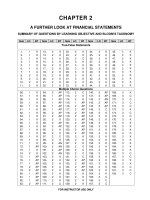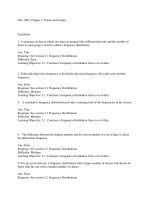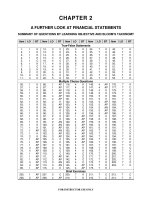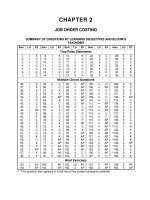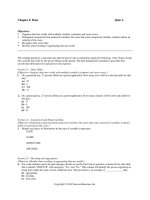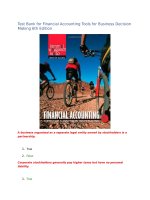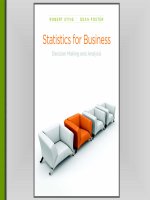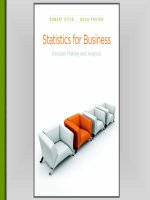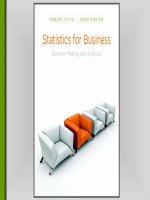Statistics for business decision making and analysis robert stine and foster chapter 12
Bạn đang xem bản rút gọn của tài liệu. Xem và tải ngay bản đầy đủ của tài liệu tại đây (453.4 KB, 45 trang )
Chapter 12
The Normal
Probability Model
Copyright © 2011 Pearson Education, Inc.
12.1 Normal Random Variable
Black Monday (October, 1987) prompted
investors to consider insurance against
another “accident” in the stock market.
How much should an investor expect to pay
for this insurance?
Insurance costs call for a random variable
that can represent a continuum of values
(not counts)
3 of 45
Copyright © 2011 Pearson Education, Inc.
12.1 Normal Random Variable
Percentage Change in Stock Market Data
4 of 45
Copyright © 2011 Pearson Education, Inc.
12.1 Normal Random Variable
Prices for One-Carat Diamonds
5 of 45
Copyright © 2011 Pearson Education, Inc.
12.1 Normal Random Variable
With the exception of Black Monday, the
histogram of market changes is bellshaped
The histogram of diamond prices is also
bell-shaped
Both involve a continuous range of values
6 of 45
Copyright © 2011 Pearson Education, Inc.
12.1 Normal Random Variable
Definition
A continuous random variable whose
probability distribution defines a standard
bell-shaped curve.
7 of 45
Copyright © 2011 Pearson Education, Inc.
12.1 Normal Random Variable
Central Limit Theorem
The probability distribution of a sum of
independent random variables of
comparable variance tends to a normal
distribution as the number of summed
random variables increases.
8 of 45
Copyright © 2011 Pearson Education, Inc.
12.1 Normal Random Variable
Central Limit Theorem Illustrated
9 of 45
Copyright © 2011 Pearson Education, Inc.
12.1 Normal Random Variable
Central Limit Theorem
Explains why bell-shaped distributions are
so common
Observed data are often the accumulation
of many small factors (e.g., the value of the
stock market depends on many investors)
10 of 45
Copyright © 2011 Pearson Education, Inc.
12.1 Normal Random Variable
The Normal Probability Distribution
Defined by the parameters µ and σ2
The mean µ locates the center
The variance σ2 controls the spread
11 of 45
Copyright © 2011 Pearson Education, Inc.
12.1 Normal Random Variable
Normal Distributions with Different µ’s
12 of 45
Copyright © 2011 Pearson Education, Inc.
12.1 Normal Random Variable
Normal Distributions with Different σ’s
13 of 45
Copyright © 2011 Pearson Education, Inc.
12.1 Normal Random Variable
Standard Normal Distribution (µ = 0; σ2 = 1)
14 of 45
Copyright © 2011 Pearson Education, Inc.
12.1 Normal Random Variable
Normal Probability Distribution
A normal random variable is continuous
and can assume any value in an interval
Probability of an interval is area under the
distribution over that interval (note: total
area under the probability distribution is 1)
15 of 45
Copyright © 2011 Pearson Education, Inc.
12.1 Normal Random Variable
Probabilities are Areas Under the Curve
16 of 45
Copyright © 2011 Pearson Education, Inc.
12.2 The Normal Model
Definition
A model in which a normal random variable
is used to describe an observable random
process with µ set to the mean of the data
and σ set to s.
17 of 45
Copyright © 2011 Pearson Education, Inc.
12.2 The Normal Model
Normal Model for Stock Market Changes
Set µ = 0.972% and σ = 4.49%.
18 of 45
Copyright © 2011 Pearson Education, Inc.
12.2 The Normal Model
Normal Model for Diamond Prices
Set µ = $4,066 and σ = $738.
19 of 45
Copyright © 2011 Pearson Education, Inc.
12.2 The Normal Model
Standardizing to Find Normal Probabilities
Start by converting x into a z-score
z=
x−µ
σ
20 of 45
Copyright © 2011 Pearson Education, Inc.
12.2 The Normal Model
Standardizing Example: Diamond Prices
Normal with µ = $4,066 and σ = $738
Want P(X > $5,000)
5,000 − 4,066
X − µ 5,000 − µ
P( X > $5,000) = P
>
≈ 1.27
= P Z >
σ
738
σ
21 of 45
Copyright © 2011 Pearson Education, Inc.
12.2 The Normal Model
The Empirical Rule, Revisited
22 of 45
Copyright © 2011 Pearson Education, Inc.
4M Example 12.1:
SATS AND NORMALITY
Motivation
Math SAT scores are normally distributed with
a mean of 500 and standard deviation of
100. What is the probability of a company
hiring someone with a math SAT score of
600?
23 of 45
Copyright © 2011 Pearson Education, Inc.
4M Example 12.1:
SATS AND NORMALITY
Method – Use the Normal Model
24 of 45
Copyright © 2011 Pearson Education, Inc.
4M Example 12.1:
SATS AND NORMALITY
Mechanics
A math SAT score of 600 is equivalent to
z = 1. Using the empirical rule, we find that
15.85% of test takers score 600 or better.
25 of 45
Copyright © 2011 Pearson Education, Inc.

